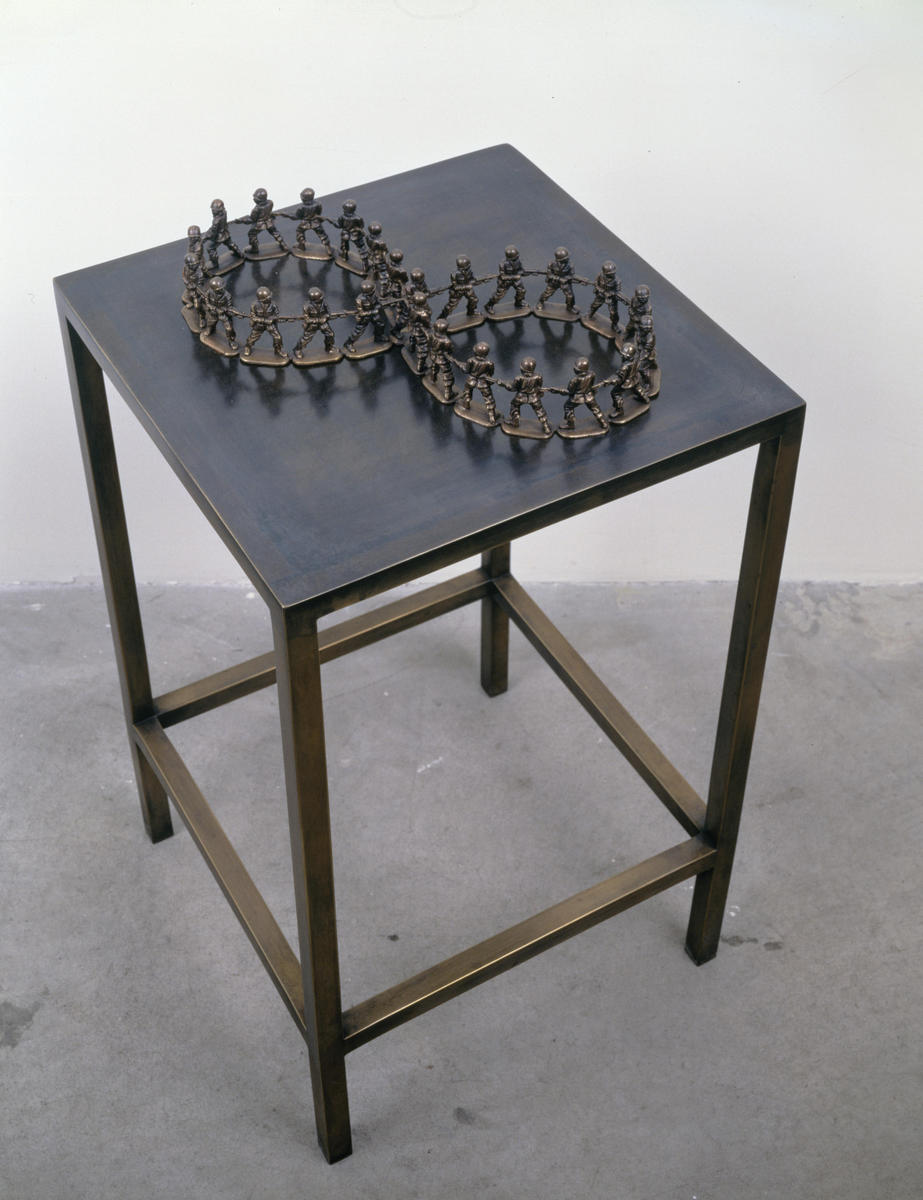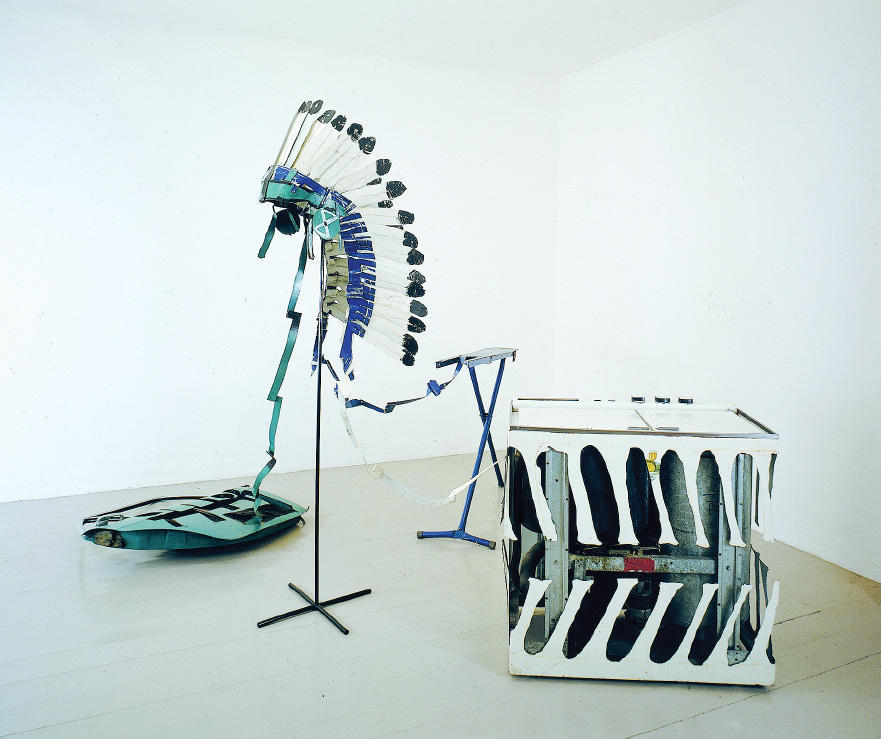
Tehran
20th Century British Sculpture
Museum of Contemporary Art
February 25–April 16, 2004
Tehran seemed the most unlikely of locales for the much-anticipated debut of Damien Hirst’s Resurrection, a life-size human skeleton impaled on Plexiglas and suggestively suspended in the form of Christ’s crucifixion. But it happened that way. Along with a number of trademark Hirst pieces, the works of fifteen British sculptors made up Turning Points this past spring at Tehran’s Museum of Contemporary Art (TMCA) — a massive ode to Britain’s contribution to the form that was perhaps unprecedented in scope, and certainly never seen in the 25-year history of the Islamic Republic.
Recognizing the contributions British sculpture has made to 20th century art, the exhibition was an ambitious homage to multiple evolutions of the sculptural form over three decades, subtly tracing its influence on other mediums. Needless to say, an exhibition of this variety would have been distinguished in any European capital — the fact that it was situated in a country readily associated with popular stereotypes surrounding its icy receptions to outside influences at large makes it all that more poignant. As does the fact that Tehran is hardly habituated to such blue-chip art in the flesh. By all accounts, Turning Points, a joint project of TMCA and the British Council, was effectively a mini — though by no means insignificant — revolution in and of itself.
Hirst, for his part, was in good company, with canonical pieces from pioneers of abstraction John Moore and Barbara Hepworth to contemporary works by artists such as Bill Woodrow, Anish Kapoor and Mona Hatoum. A selection of Woodrow’s works exhibited the artist’s preoccupation with notions of history vis-à-vis the contemporary. His Car Door, Ironing Board and Twin-Tub with North American Indian Head Dress (1981), fashioned out of industrial and consumer tins, manifests the human capacity to package human narratives as consumer goods — perhaps holding increased resonance in Iran, a country whose own history of revolution continues to be aestheticized and marketed in popular fashion.
Kapoor’s void pieces — ruminations on the ambiguous creation/removal of space, as well as his pigment sculptures, where shape and pure color become one in a near-scientific continuum — were installed in the depths of the museum’s subterranean exhibition halls. Lebanese-born Palestinian Hatoum had a broad range of her works on display, from the disconcerting Incommunicado — a baby cradle fashioned from steel and wire and decidedly penitentiary-esque — to a vertigo-inducing Deep Throat, a video documentation of an endoscopy in the artist’s own body, projected from an LCD screen embedded on an innocent dinner plate. Hatoum’s refusal to abide by the neat conventions of the quotidian object and its associated functions raised more than a few eyebrows at the TMCA, where conceptual art has rarely assumed such aggressive, if not unpleasant, forms.
Importantly, several works exhibited the wide parameters of the sculptural form. Hatoum’s graphic work, as well as Hirst’s drawings and pharmaceutical posters, managed to extend definitional notions of sculpture while displaying the rich diversity of the medium. Gilbert and George’s sculptures on video, Portraits of the Artist as Young Men and In the Bush, were perhaps the most mind-bending. It was not uncommon to see slightly dumbfounded viewers situated in front of the pair’s works. Perhaps only in Tehran could viewers openly question Art in a manner that is haram in the Western art world. Naiveté is certainly out in London, but may have occasionally found a (refreshing) home within the halls of the TMCA.
While an exhibition of this ambitious nature and scale would be noteworthy independent of venue, the temptation to examine the exhibition through the lens of politics is admittedly irresistible. After all, the British in Iran occupy a singular position, as years of quasi-colonialism via significant influence over the running of the country has left a chronic outsider wariness in some circles — particularly official ones. Complicating matters, the onset of war in Iraq raised questions surrounding the appropriateness of such an exhibition, while diplomatic squabbles between Tehran and London with regard to the arrest of an Iranian diplomat tied to the 1994 bombing of a Jewish community center in Argentina pushed a revised date back once again (the original opening was meant to be five months earlier, in September).
Turning Points opened in February, arriving on the heels of one of the most contested parliamentary non-elections since the 1979 Revolution, one in which over 2000 candidates were disqualified by the hard-line supervisory Guardian Council. Making the confluence of time and space perhaps even more loaded is the fact that the TMCA exhibition took place in the midst of the 25th anniversary of the Islamic Revolution — a revolution that deemed Western influence a categorical evil.
Andrea Rose, Director of Visual Arts at the British Council, who along with the Council’s Richard Riley led the Turning Points curatorial team, considered the seductive question of politics, cultural imperialism and the rest: “I don’t think that it is possible to do anything in Iran without it being considered in political terms. This is a sine qua non of the situation there.” She continued: “I do think that there are many Iranians who would like to have contact with Western ideas and that this exhibition provided them with that in some measure… This is surely the value of cultural exchange, where one is able to talk to people about common cultural concerns, free of the pressures of established government positions.”
And importantly, Iran has changed considerably in the 25 years since its Revolution, most visibly with the election of decidedly reformist President Mohamed Khatami in 1997 — a poster boy for a new generation seeking change, especially the roughly 70 percent of Iranians who are under the age of 30. Though many today deplore Khatami’s failure to deliver on the enormous expectations pinned to his election, his presidency has coincided with a period of increased dialogue with the outside world, and presumably created an environment in which such exchange initiatives can take place.
“It is no coincidence that Iran’s relations with Europe are good at the moment. This particular exhibition would not have happened amidst the climate of five years ago,” adds Yaghoob Emdadian, a long-time TMCA curator who, along with museum Director Ali Reza Sami Azar, was part of the local curatorial team.
As with many countries in this region in which self-expression is placed at a premium and censorship is a rule of thumb, politics and the arts are often linked in intimate fashion. Nevertheless, within the Turning Points selection, only two works from the original lineup were removed, and those at the behest of the British Council rather than Iran’s governing Ministry of Culture and Islamic Guidance. It was neither sex nor revolutionary politic that offended the sensors but a wheelchair and a prayer rug (suggestively with needles emerging erect at the point where one would usually lay one’s head down), both pieces by Hatoum, that did not make the cut. Both were deemed potentially insensitive in light of Iran’s predominantly Muslim population, as well as the significant contingent of veterans care of a grueling eight-year war with neighboring Iraq during the 1980s.
And while an impressive crash course in art history for Tehranis, Turning Points was not the alien imposition on a tabula rasa many have imagined. On the contrary, young Tehranis are savvy and well versed in the arts. It is perhaps decades of isolation that have given rise to an exaggerated knowledge about the surrounding world. In this neighborhood, it is not uncommon to encounter art students deconstructing the history of the realist tradition in French cinema or the influence of Warburg’s Mnemosyne Atlas on conceptions of contemporary photography. While access is limited, a hyper interest in the surrounding world, combined with enhanced access to Internet and satellite television, have further tied Iranians into an international fabric that defies trite images of isolation and naiveté, artistic or otherwise.
Dr. Stephen Deuchar, director of the Tate Britain, attended the opening of Turning Points and remarked at the potential of Iran to become a serious venue for the arts — particularly amidst post-modernism’s legacy of inclusion and the advent of alternative urban venues such as Johannesburg, Ljubljana and most recently, Istanbul: “The level of intellectual and cultural stimulation is significant, and I would be surprised if the heights scaled by Iranian cinema were not also reached eventually by other art forms. Iran can become a big player in the international arts scene.”
Indeed, beyond the international festival-heavy cinema realm, a generation of young Iranian artists are part and parcel of a remarkable movement in the arts. Novel expression via photography, installation, performance and beyond are defying the dictates of the local market’s decorative and/or religio-nationalist tendencies, as well as the ethnic marketing efforts of the West (i.e. Iranian art has to necessarily address Islam, the veil or the geopolitics of oil). Exhibitions in official and non-official spaces take place much and often, while art, architecture and design magazines are ubiquitous, as are festivals of both Iranian and foreign film.
And so in the end, Turning Points was not an extraordinary gesture in isolation, but rather, perhaps an extension of movements already in progress. The TMCA, for its part, is in the process of planning a retrospective of the works of both Gerhard Richter and Turner Prize winner Rachel Whiteread for the coming year, while rumors abound that there are a number of treasures within the museum’s underground collection that may get some playing time (a gem of a Pollock and trademark Warhol among them) in the near future. It seems that Tehran may be turning traditional notions of center-periphery on their collective heads.
www.ir.tmca.com
